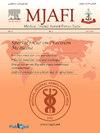Which test results to believe? Comparison of different ELISA kits for detection of SARS-CoV-2-neutralizing antibody among COVID-vaccinated individuals
Q2 Medicine
引用次数: 0
Abstract
Background
In the context of SARS-CoV-2, infection and immunization lead to varied levels of neutralizing antibodies (NAbs) crucial for protective immunity. In the lack of universal availability of plaque reduction neutralization tests, the gold standard centers rely on surrogate kits, for which performance standards and validation are lacking. Hence, we assessed three NAb kits available in India to determine their agreement and concordance.
Methods
It's a single-center cross-sectional observation study conducted during the third wave of the pandemic starting in January 2022 amongst individuals (n: 247) who received the first two doses of CovishieldTM. Samples were analysed using kit-A (Indian Council of Medical Research (ICMR) approved NAb microlisa kit, J. Mitra & Co. Pvt. Ltd), kit-B (Food and Drug Administration–approved NAb surrogate virus neutralisation test, GenscriptTM), and kit-C (NARI- and ICMR-approved anti–SARS-CoV-2 IgG antibodies kit using indirect ELISA principle, ErbaLisa® COVID-19 IgG). Cohen's kappa and concordance were analyzed using JMPver20.0.0.
Results
NAb was detected in 80.4%, 82.9%, and 21% samples using the three different kits. Discordance was observed in 19.68%, 65.7%, and 62.6% between Kit A-B, A-C, and B-C, respectively. The agreement was fair between Kit A-B (κ-0.35; p: 0.06) and Kit B-C (κ-0.09; p: 0.0005). Kit-B showed higher mean percentage inhibition (74.6 ± 32.1%) than Kit-A (68.1 ± 35.7%) (p: 0.0347). The correlation between kit-A and kit-B was moderate (r: 0.57; p < 0.0001).
Conclusion
There is significant discordance between various commercials, which raises questions about their validity. The research underscores the need for robust validation and standardization of NAb tests to ensure their reliability and effectiveness in guiding public health strategies.
该相信哪种检测结果?比较不同的 ELISA 试剂盒检测接种过 COVID 疫苗的人体内的 SARS-CoV-2 中和抗体
在SARS-CoV-2的背景下,感染和免疫导致不同水平的中和抗体(nab),这对保护性免疫至关重要。由于缺乏普遍可用的斑块减少中和试验,金标准中心依赖于缺乏性能标准和验证的替代试剂盒。因此,我们评估了印度现有的三种NAb试剂盒,以确定它们的一致性。方法这是一项单中心横断面观察研究,于2022年1月开始的第三波大流行期间在接受前两剂CovishieldTM的个体(n: 247)中进行。使用kit- a(印度医学研究委员会(ICMR)批准的NAb microlisa试剂盒,J. Mitra &;kit- b(美国食品和药物管理局批准的NAb替代病毒中和试验,GenscriptTM)和kit- c(使用间接ELISA原理的NARI和icmr批准的抗sars - cov -2 IgG抗体试剂盒,ErbaLisa®covid - IgG)。采用JMPver20.0.0分析Cohen’s kappa和一致性。结果3种试剂盒中snab的检出率分别为80.4%、82.9%和21%。Kit A-B、A-C和B-C之间的不一致性分别为19.68%、65.7%和62.6%。Kit A-B (κ-0.35;p: 0.06)和Kit B-C (κ-0.09;p: 0.0005)。Kit-B的平均抑制百分比(74.6±32.1%)高于Kit-A(68.1±35.7%)(p: 0.0347)。kit-A与kit-B的相关性为中等(r: 0.57;p & lt;0.0001)。结论不同广告之间存在显著的不一致性,对广告的有效性提出了质疑。该研究强调需要对NAb测试进行强有力的验证和标准化,以确保其在指导公共卫生战略方面的可靠性和有效性。
本文章由计算机程序翻译,如有差异,请以英文原文为准。
求助全文
约1分钟内获得全文
求助全文
来源期刊

Medical Journal Armed Forces India
Medicine-Medicine (all)
CiteScore
3.40
自引率
0.00%
发文量
206
期刊介绍:
This journal was conceived in 1945 as the Journal of Indian Army Medical Corps. Col DR Thapar was the first Editor who published it on behalf of Lt. Gen Gordon Wilson, the then Director of Medical Services in India. Over the years the journal has achieved various milestones. Presently it is published in Vancouver style, printed on offset, and has a distribution exceeding 5000 per issue. It is published in January, April, July and October each year.
 求助内容:
求助内容: 应助结果提醒方式:
应助结果提醒方式:


